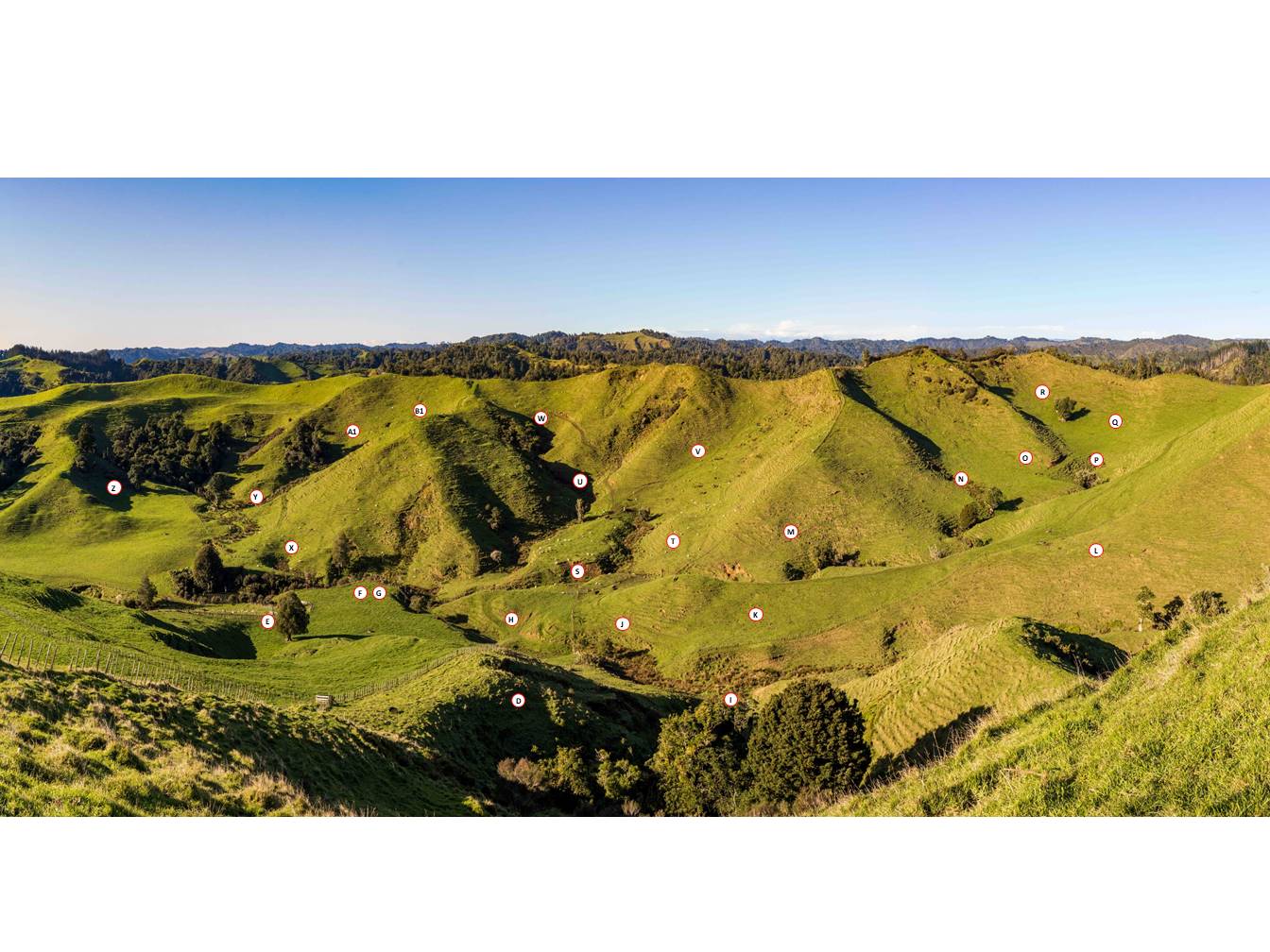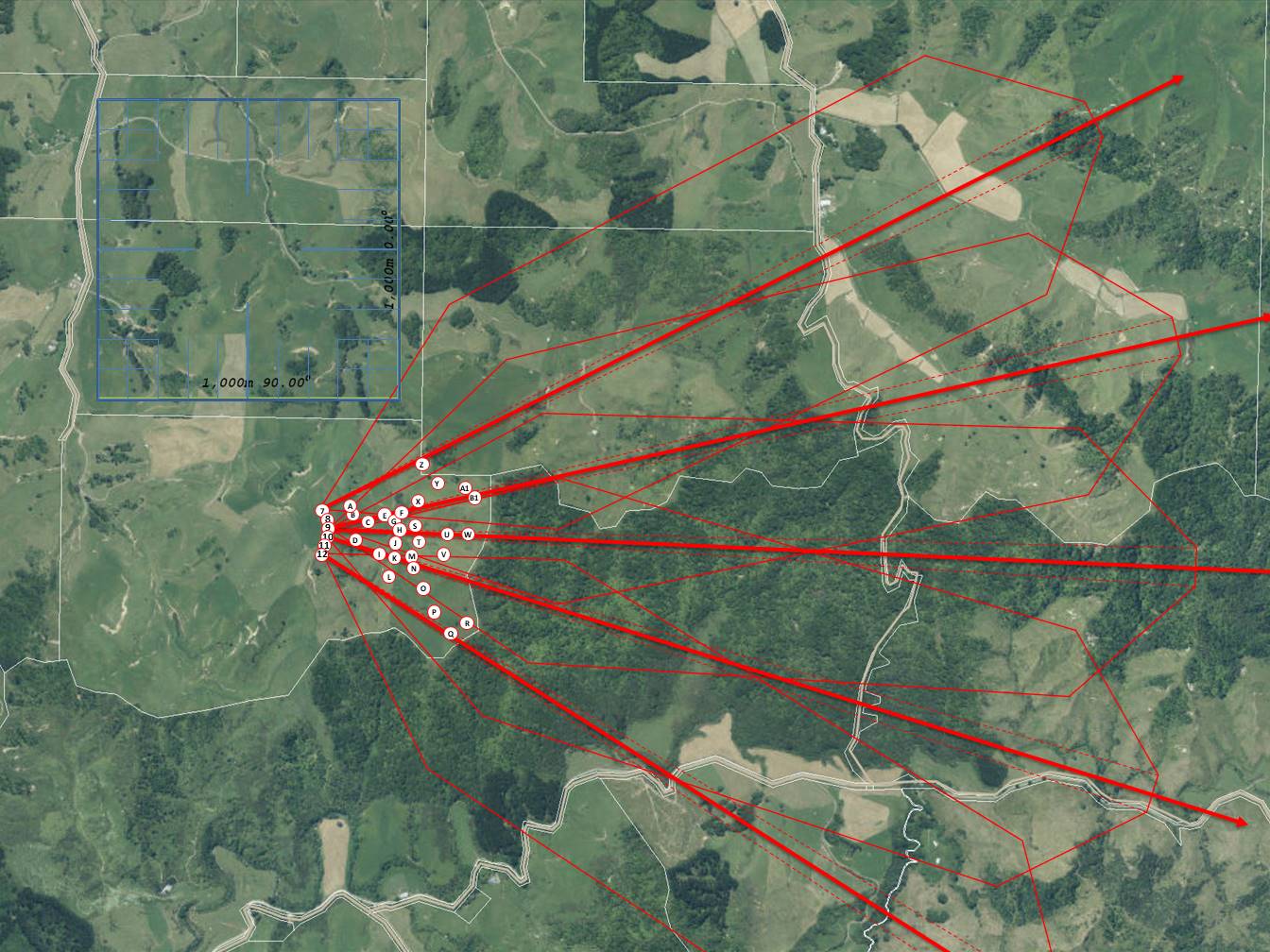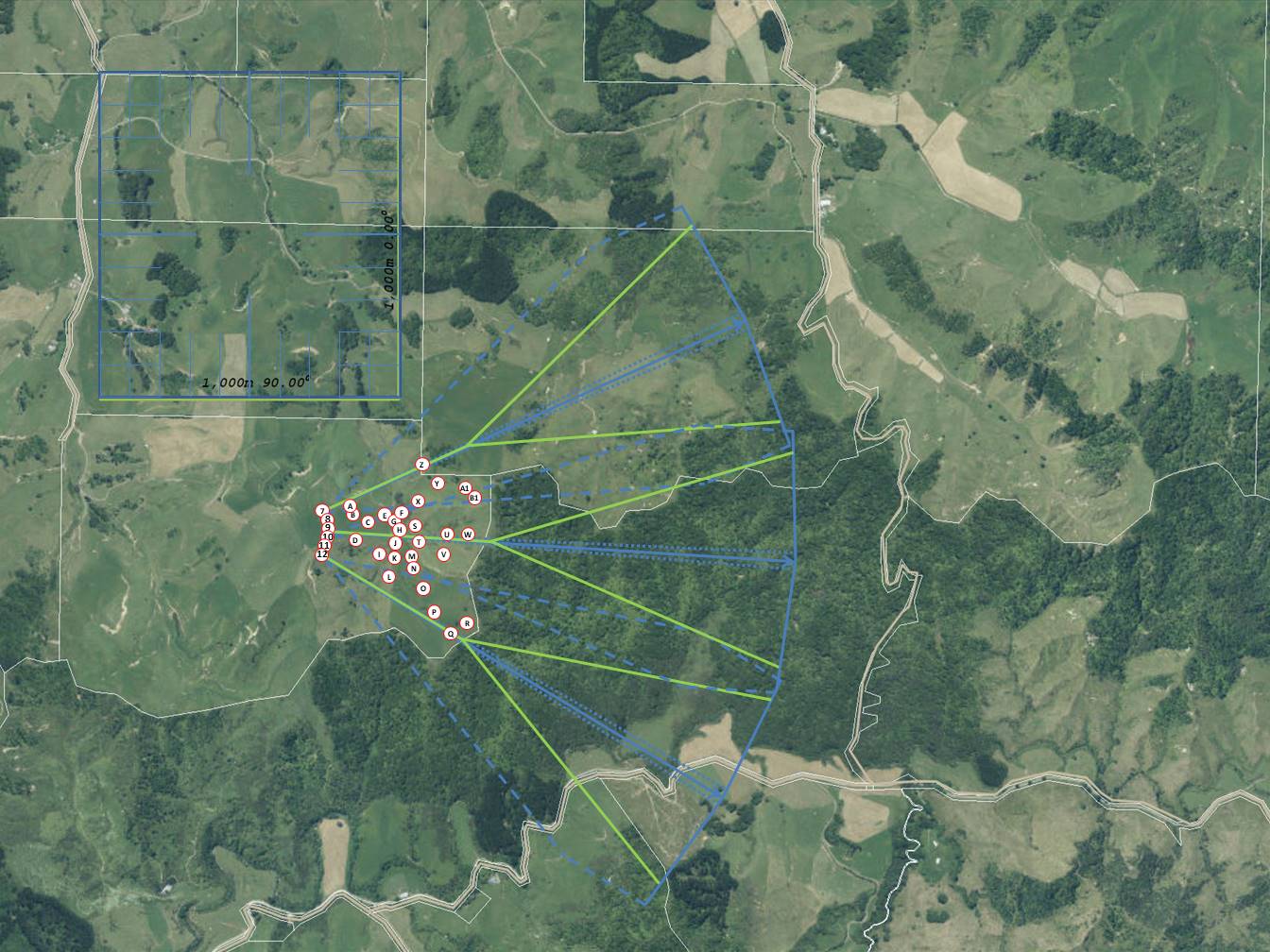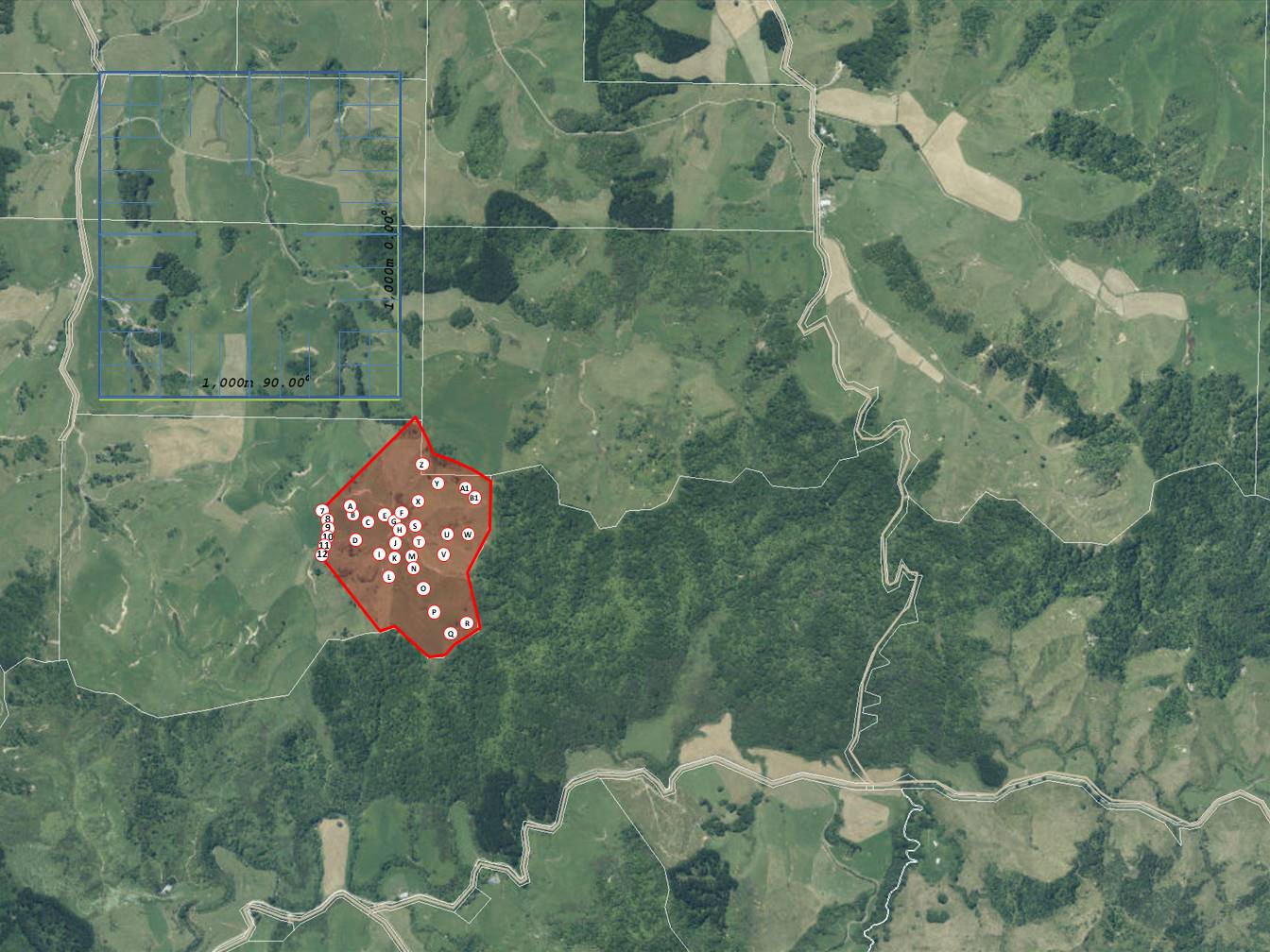Field Ranges in NZ - Reduced Danger Area Example
The intent of this post is to demonstrate there is a Reduced Danger Area system that can be used under the NZ Firearms Safety Authority range certification regime. There are some significant limitations to its use at the moment and we are continuing to work on that in the background. And this system is fairly specific, at the moment, to field ranges (i.e. not permanently established ranges).
I also have to clarify I am going to leave out a whole bunch of information and application criteria from this post.
Photo 1
Photo 1 is taken on a GPRE range looking downrange at a bunch of indicative target locations on the hills. There are a few things of note here - primarily all the targets and their applicable "Cones of Fire" are below the hill crest, also the vast majority of the targets are on a slope.
Photo 2
Photo 2 is the aerial photo of the same range with the same indicative target arrangement. I have overlaid the NZ Firearms Safety Authority T6 ADAT template here as well. This T6 template is suitable for calibres up to 8mm. The resulting Range Danger Area is roughly 3km in depth. For clarity I will call this a Tier 1 system.
Photo 3
Photo 3 is the same aerial photo and target layout. This time I have overlaid the applicable FSNZ Reduced Danger Area Tier 2 Template - this template is suitable for targets out to 500m and calibres "up to 8mm". You can see the resulting range danger area is a lot smaller than the FSA one.
Photo 4
Same aerial photo with the shoot positions and indicative target locations overlaid. This time I have overlaid the range danger area when the FSNZ reduced danger area Tier 3 criteria is applied. I have to clarify here that it takes a considerably amount of work and on the ground measurement to be able to make the leap from applying the Tier 2 template in the previous photo to being able to apply the Tier 3 reduced danger area criteria. Not every location needs this Tier 3 step and it isn't suitable for every location either.
Coming out of this is the big question why is the FSNZ RDA template so much smaller than the FSA one? Or why is the FSA T6 template so large.
To be very clear the FSA T6 ADAT template shown here is not "wrong" - it is simply based upon some simple assumptions. One of those assumptions is that the projectile is fired on a set angle and the template reflects where that projectile would come back down to a flat plane i.e. the template reflects how far a projectile could travel based upon being fired at set angle "X".
The FSNZ RDA template makes a massive assumption - it assumes the fired projectile impacts the ground at or immediately around the target location. After that it considers a "simplistic / conservative" ricochet template.
You can see why the indicative target locations are all on slopes and also why we have the rule where you can only close the bolt with the rifle shouldered and pointed at the target. These are only two of the actions we take to ensure we keep projectiles within the RDA.
I won't go into the Tier 3 criteria here because this post is already far too long.
Again, the intent of this post is to demonstrate there is a reduced range danger area templating system out there for use with field ranges in NZ. This system is set up for rifle calibers from 22LR all the way up to .50BMG.
Lastly, this system is not mine - it was created by a number of the field range match directors in NZ. And, as above, there is still some further development works going on in the background.
Welcome guest, is this your first visit? Create Account now to join.
Welcome to the NZ Hunting and Shooting Forums.
Search Forums
User Tag List
+ Reply to Thread
Results 1 to 8 of 8
 34Likes
34Likes
Thread: Field Ranges in NZ - Reduced Danger Area Example
-
06-07-2023, 09:39 PM #1Member

- Join Date
- May 2012
- Location
- Taranaki
- Posts
- 1,695
Field Ranges in NZ - Reduced Danger Area Example
You cannot miss fast enough!
Facebook: https://www.facebook.com/GPREventsNZ
Youtube: https://www.youtube.com/user/sgil045
-
-
06-07-2023, 10:25 PM #2Member

- Join Date
- Jul 2012
- Location
- Invervegas
- Posts
- 5,663
Thanks for taking the trouble to share and explain this. Couple of questions if you can . . . .
Why are calibre limits being used as opposed to energy limits?
In the tier 3 scenario is the slope behind the target (effectively the bullet stop) the key factor?
Thanks
-
07-07-2023, 08:10 AM #3Member

- Join Date
- May 2012
- Location
- Taranaki
- Posts
- 1,695
Thanks @Tentman, some good questions - I mentioned I would leave a bunch of stuff out.
Your first question - energy doesn't necessarily translate well to the "how far will a projectile travel" question. It does come into the ricochet ballistics a bit as it is a consideration of the residual kinetic energy of the ricocheted projectile. Energy is also really handy to know at the impact point when looking at protective structures or target suitability (e.g. determining a suitable steel target thickness). Energy is also a variable that not a lot of "normal" shooters are familiar with - calibers / cartridges are. The caliber limitation mostly works as a simplistic measure that is fairly easy for most people to understand and it is fairly easy to "police" onsite (no chronograph required) - there are some obvious exceptions around black powder rifles (which are excluded entirely at the moment) and the big caliber air rifles. The "Up to 8mm" designation also falls over with some of the magnum calibers (e.g. 28Nosler, 300PRC and 300Norma).
Our system is broken down into:
22LR - covers most rimfire cartridges.
308Win - covers all “standard” non-magnum cartridges up to 8mm in caliber including but not limited to 223Rem, 243Win, 270Win, 284Win, 30-06 Springfield, etc. Also includes the smaller magnums including 6.5PRC, 264WinMag, 7mmRemMag, 300WinMag, etc.
338Lapua - covers all magnum cartridges including but not limited to 28Nosler, 300PRC, 300NormaMag, 338Edge, etc.
50BMG - covers all large magnum cartridges including but not limited to 375CheyTac, 416Barret, etc.
Your second question - the slope angle is one of a bunch of variables in the Tier 3 system (I find it easier to consider "impact angle"). But on top of that, ground material, land usage, target distance / cartridge template applied, governing ricochet angle, line of fire angle, cone of fire size, etc. all come into the Tier 3 system.
In the example above, the Tier 3 range danger area is made up of both targets where ricochet is credible and targets where ricochet is not credible. Where ricochet is credible, the range danger area for some targets is limited by the line of fire angle, and for others the height of the hill behind catches the ricochet. Then lastly, just because ricochet is not credible at a particular target location that doesn't mean there is not a range danger area - I would be "uncomfortable" enough to stop shooting if someone walked over the hill the target is on even though they were technically outside of the cone of fire...You cannot miss fast enough!
Facebook: https://www.facebook.com/GPREventsNZ
Youtube: https://www.youtube.com/user/sgil045
-
07-07-2023, 11:31 AM #4
So I'm guessing a 38/55 should identify as a 30 cal? But where do the likes of the 35 Whelan, 358 win 9.3x62 and 375H&H sit. They're not long range target rounds but are perfectly capable hunting rounds and you occasionally see them on ranges. There were a few big bore shoots organised a few years ago max range 200m it would be nice to see come back.
-
07-07-2023, 11:36 AM #5Member

- Join Date
- Dec 2021
- Location
- Tauranga
- Posts
- 6,048
The classification of cartridges is an interesting one, you always get outliers that stuff the simple classifications up. If you go bullet diameter as the restriction you can still get cartridges that have a serious amount of energy that could go well over range design limits in terms of energy absorbtion at the butts but within the bullet diameter limit.
The other end of that, is larger diameter small case rounds that are comparatively lower in energy and within range design limits but excluded by caliber.
Then you get the real anomalies like bolt action 12ga rifled barrel shotguns - not fast but massive energy and feel the width of the projectile haha. Some of the sniders and the like with cased rounds but in the larger calibers are up there as well as are some of the big African rifles.
Not too sure how you fix those issues and still have a simple system that new chums can understand...
-
07-07-2023, 12:02 PM #6Member

- Join Date
- May 2012
- Location
- Taranaki
- Posts
- 1,695
This system was set up by the match directors who are mainly doing practical rifle competitions, long range shooting on farms, "PRS" style events, etc. and so its focus was toward common calibers used in those disciplines.
We followed the NZ FSA designation for their 308Win template being "up to 8mm" (we investigated it ourselves as well) but as I mentioned above the system isn't perfect for the outliers - hence the list above in post #3.
Caliber equivalence tables... The ricochet templates we have were set up based, generally, upon the heavier, higher BC projectiles in the various calibers we checked to give a conservative estimate of the distances as well.
It hasn't been written so far but it would be a fairly simple (though a little time consuming) task to write out under which class various calibers come under.
@Marty Henry, if the people running those big bore matches want to get in touch, I am sure we can set up a suitable template for them or do some investigation on where the various big bore calibers sit within the current templates we have. Or alternatively they will all sit under the 338Lap template ballistically.
I did set up some templates for pistol calibers - I ended up looking at cartridges like 9mmPara, 38Special, 357Mag, 45Long Colt, etc. I have started to look at the 177cal and 22cal air rifles as well but there are some powerful air rifles out there at the moment so an energy or velocity limit might have to be considered there.
@No.3, yep I completely agree - we wanted simple and simple doesn't work for everything and everyone.You cannot miss fast enough!
Facebook: https://www.facebook.com/GPREventsNZ
Youtube: https://www.youtube.com/user/sgil045
-
07-07-2023, 12:13 PM #7Member

- Join Date
- Jan 2021
- Location
- Methven
- Posts
- 156
A huge thanks to you and the others that are doing this work Simon, I can't imagine the hours and problems you guys will have had to work through.
If someone wants to set up a range under any of the tiers, what does that process roughly look like?
Is it any different for Tier 3 than the others? (other than the obvious work)
-
07-07-2023, 01:19 PM #8Member

- Join Date
- May 2012
- Location
- Taranaki
- Posts
- 1,695
2 years I have been working with Police (now Firearms Safety Authority) and we have only got this system across the line a couple of months ago - didn't leave a lot of time before the 24th of June.
So I think I mentioned some limitations on its use - to use this system you either need to be a FSNZ member match director (and accepting new membership is one of the things FSNZ still needs to clarify) or you need to engage one of the FSA recognised range inspectors who is also a FSNZ member match director (there is a couple in the North Island and at least a couple in the South Island).
One of the bits of ongoing development is around getting some wider roll out - that isn't so easy given the so few people familiar with the system and the relative complexity involved in the Tier 3 system.
Basic process would be something like:- Range Operator decides what sort of range they want to operate: e.g. Where they want the range (shoot positions typical target locations), what sort of shooting will be done and what would be the cone of fire for that shooting, what calibers and cartridges they want to be able to use the range, etc.
- Range Operator plots the range onto a topographical map or a scaled aerial photo along with the property boundaries.
- Range Operator writes their Range Standing Orders (RSOs) for the range (FSA have a good template for this on their website).
- Range Operator engages a FSA recognised Range Inspector (refer the FSA website for the list and contact details).
- Range Inspector reviews the RSOs and range map and will need to inspect the site.
- Now assuming the Range Inspector has access the FSNZ Tier 2 system:
- The Range Inspector visits the site and looks over the proposed impact areas to determine make sure it meets the FSNZ system requirements. If it does, then they can overlay the applicable Tier 2 range danger area template on the range map for the applicable cartridges and target distances.
- The Range Inspector can also determine from the template (and the associated ricochet trajectory curve) if any hill backstop criteria could be used to limit the range danger area.
- Range Operator updates their RSOs accordingly.
- Range Inspector signs off their inspection report.
- Range Operator submits their range certification application (with RSOs, range map, range inspectors report) to FSA and pays their fee.
- FSA review the application and issue the certificate.
If the Range Inspector has access to the FSNZ Tier 3 system (and the range needs / wants to use it) then they will visit the site and measure it up to be able to determine and apply the Tier 3 system.
The Tier 3 system can be a bit step by step as you look at individual target locations. You end up overlying the associated danger areas for all the individual targets to show the entire range danger area.
The Range Operator updates their RSOs accordingly...
The other method that has been used is if you have a large enough property is you apply the largest caliber / cartridge ricochet Tier 2 template to the property boundaries and the area you are left within in the middle becomes the "Active Range Area". The Range Operator can then do whatever they want with targets within that area then. A range like Sparrowhawk in the South Island could be set up like that within reason.You cannot miss fast enough!
Facebook: https://www.facebook.com/GPREventsNZ
Youtube: https://www.youtube.com/user/sgil045
Similar Threads
-
DANGER
By Woody in forum HuntingReplies: 17Last Post: 01-05-2021, 02:24 AM -
DANGER
By Woody in forum ShootingReplies: 11Last Post: 30-04-2021, 05:53 PM -
Ohakune area rifle ranges?
By hebe in forum ShootingReplies: 4Last Post: 23-03-2017, 09:42 AM -
Ranges in Wellington area
By misha2001 in forum ShootingReplies: 10Last Post: 17-07-2015, 11:54 AM -
Rifle ranges in the Franklin area
By Steve123 in forum ShootingReplies: 21Last Post: 28-06-2015, 09:51 AM
Tags for this Thread
Welcome to NZ Hunting and Shooting Forums! We see you're new here, or arn't logged in. Create an account, and Login for full access including our FREE BUY and SELL section Register NOW!!






 LinkBack URL
LinkBack URL About LinkBacks
About LinkBacks







 Reply With Quote
Reply With Quote



Bookmarks